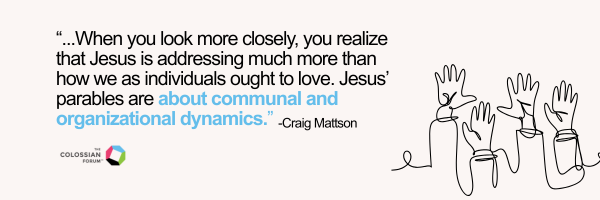|
This fall, I’m teaching a digital storytelling course at Calvin University, a master’s course focused on helping organizations tell their story well. Because of Calvin’s Christian identity, I invariably reference Jesus’ storytelling techniques, especially in parables like the Good Samaritan. Jesus’ stories sometimes sound directed towards the individual alone — stories about how I should take care of my neighbor. But when you look more closely, you realize that Jesus is addressing much more than how we as individuals ought to love. Jesus’ parables are about communal and organizational dynamics.
But the Good Samaritan story includes more collective troubles than at first meet the eye. Those bandits were in a group. Those religious leaders served a temple community. The ethnic assumptions Jesus undercut were widely shared. Jesus’ plot points indicate more communal and organizational dynamics than meet the individualist eye.
Over my years of teaching storytelling, I’ve often drawn on stories from my half dozen trips to Haiti. Like so many Americans in the late 2000s, I joined teams doing development work. Because I couldn’t speak much Creole, I was often more of a witness than an active contributor. (Sometimes, I wished I were a nurse practitioner so I could be of more use on sweaty afternoons in Les Cayes and not just a blood-pressure taker or a distributor of vitamin baggies).
One day, one of our medical teams was roaring down the road in a school bus, when the driver hit the brakes. The doctors spilled out into the road to find a man sprawling beside the ditch: he’d been struck by the bus’s mirror. The ice chest he’d been carrying on his head had spilled out cubes whose impact radius marked a darkly ironic story:
Our doctors were there to heal. Their collective presence had done the opposite.
That moment exposed something uncomfortable: good intentions don’t automatically translate into good impact. Our group was large, foreign, and operating on our own sense of urgency. We came to serve, but we didn’t always see the systems we brought with us — our schedules, our assumptions, our power to disrupt.
That experience has stayed with me — a kind of modern parable about how even our best intentions can go awry when our collective pace or approach goes unexamined. As an organizational leader, you might catch yourself asking, when my community causes harm, what can we do to course-correct? I have three ideas to consider.
- Watch the bus, not just who is boarding. Reconsider the various “vehicles” your organization uses to connect with its community. For example, think about your preferred mode of communication, not just the content of your message. Some modes have great reach, for example, but don’t create much interaction. Others are great for one-on-one but are hard to scale. Climbing aboard just the right mode will help you reach your constituents generously and wisely.
- Complicate your fact patterns. When conflict arises, don’t look for one villain alone. Look for interconnected causes. Practicing curiosity about the diverse contributors to a problem will help you spot your own organizational contributions to the predicament—while not piling on the shame and guilt.
- Slow your processes. Everybody’s moving too fast these days. But would more margin in our processes help avert institutional injury? Some organizations practice Wellness Wednesdays or No-email Fridays to encourage breathing time and shared attentiveness.
Your communal story doesn’t have to have an ironic twist like the doctors-on-the-bus story above, especially if you and your team ask Jesus’ who-was-the-neighbor question and then answer it with collective awareness.

|

